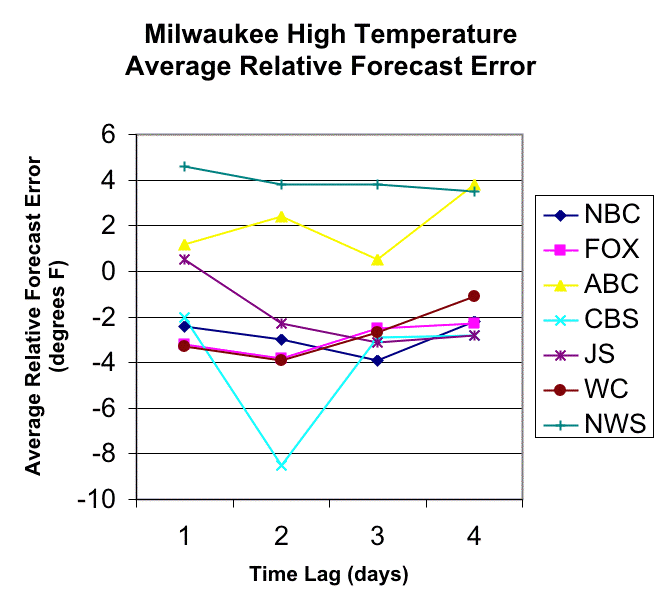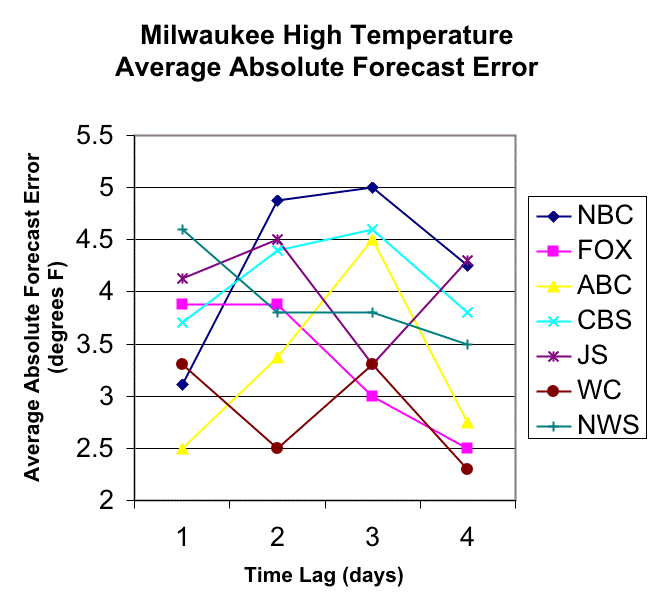Finding the Websites
You can access the web sites for your local TV stations through the main station’s web page (for example, www.foxnews.com). If this does not work, you can attempt to do a search from an Internet search engine such as google or yahoo. If you don’t have access to the Internet, you can record the forecasts directly from the television or newspaper.
Collecting the High Temperature forecasts
On Monday, you will collect the high temperature forecast for Tuesday, Wednesday, Thursday and Friday. On Tuesday, you’ll collect forecasts for Wednesday, Thursday, Friday and Saturday. [See the table on the Process page for further details.] You’ll do this on Monday through Friday of the first two weeks, collecting forecasts for Tuesday – Saturday.
Newspapers and television stations often present their forecasts in the form of a picture showing high and low temperatures for the next several days:

Some stations may substitute “tomorrow” with the day of the week.
There are different ways in which forecasts can be expressed:
- For forecast that are numerically expressed, simply copy the number (High: 75)
- For forecasts which are expressed in numerical ranges (High: 65 – 70), take the average of the range:

- For forecast which are expressed in words (for example, “High in the Mid 70’s”), follow these examples:
- Near 70 = 70
- Lower 70’s = 72
- Low to Mid 70’s = 73
- Mid 70’s = 75
- 70’s = 75
- Mid to Upper 70’s = 77
- Upper 70’s = 78
- Near 80 = 80
Verifying the High Temperature Forecasts
One easy way to verify high temperature forecasts is to use the Weather Underground website, www.wunderground.com. Go to this web site and type in the city name at the top of the page. For cities that appear in more than one state (like Miami) you may need to select the appropriate city from a list. Select your city by clicking on its name. You will be taken to a web site containing current weather conditions and forecasts for your city. At the bottom of the table containing current weather conditions there is a section called “Historical Conditions.” Use the drop-down menus to enter the proper dates and click on “Go.” The data that you want is “Max Temperature.” Do this for each day for which you collected high temperature forecasts (Tuesday – Saturday of the first two weeks).
Finding the Average Relative Forecast Error (ARE)
The first step in finding the average relative forecast error for a particular set of forecasts is to find the relative error (RE) for each forecast:
For example, if FOX forecasted a high of 65 F, and actual high was 67 F, the relative error would be -2 F. If the actual high were 63 F, the relative error would be 2 F.
The average relative forecast error (ARE) is the average of all the relative errors corresponding to a particular set of forecasts:

The formula for ARE simply divides the sum of all of the relative forecast errors by the number of forecasts made. For example, suppose a forecaster made five forecasts (n=5), and the relative errors were 3 F, 2 F, 5 F, -4 F and 0 F. Using the formula above, the average relative forecast error is
or
ARE = 1.2 F
Note that the relative error, and also the average relative error, can be either positive or negative. (It could also be zero.) The implications of these possibilities are:
- + Average Relative Forecast Error:
- Bias toward overprediction, indicating that the forecasts are generally too warm
- – Average Relative Forecast Error:
- Bias toward underprediction, indicating that the forecasts are generally too cold
So what does this tell us?
In the example given here, an average relative forecast error of 1.2 degrees F indicates that on the average, the forecasts are too high by a little more than 1 degree F.
Finding the Average Absolute Forecast Error (AAE)
The first step in finding the average absolute forecast error for a particular set of forecasts is to find the absolute error (AE) for each forecast:
You can see from the formula that the absolute error is just the absolute value of the relative error. Using the same example as before, if the forecast was for a high temperature of 65 F and the actual high temperature was 67 F, the absolute error would be 2 F (even though the relative error is -2 F). If the actual high were 63 F, the absolute error would still be 2 F. In this latter case, the absolute error would be exactly the same as the relative error. (NOTE: The absolute error can never be negative).
The average absolute forecast error (AAE) is the average of all the absolute errors corresponding to a particular set of forecasts:

The formula for AAE, just like the earlier formula for ARE, simply divides the sum of all of the absolute forecast errors by the number of forecasts made. Using our earlier example, suppose a forecaster made five forecasts (n=5), and the relative errors were 3 F, 2 F, 5 F, -4 F and 0 F. The absolute errors corresponding to these forecasts would be 3 F, 2 F, 5 F, 4 F and 0 F. Using the formula above, the average absolute forecast error is
or
AAE = 2.8 F
So what does this tell us?
In the example given here, an average absolute forecast error of 2.8 degrees F indicates that on the average, the forecasted high temperature differs from the actual high temperature by 2.8 degrees F.
Preparing Individual and Group Reports
Examine your results, both individually and as a group, and figure out what is implied by the different data.
Individual reports should address the following questions for the particular forecasters you studied:
- Which type of forecast was the most accurate: 1-day, 2-day, 3-day or 4-day? Explain your answer.
- Do the average relative errors get larger or smaller as the lag time increases? What about the average absolute errors? Is this what you would have expected before you started the project? How can you explain your observations?
- Describe the bias in 1-day and 2-day high temperature forecasts. How does this compare to the bias in 3-day and 4-day forecasts?
Group reports should address the question posed at the beginning of this WebQuest: How does the accuracy of a weather forecast deteriorate as the forecast is extended further and further into the future?
As described earlier in the Task section, the group report should include two graphs: one showing the average relative error vs. forecast type (1-day, 2-day, 3-day or 4-day), and the other showing the average absolute error vs. forecast type. Choose a color for each forecaster and graph your results.
Here are some sample graphs we prepared for Milwaukee, Wisconsin forecasters:
Graph 1: Average Relative Forecast Error vs. Lag Time

Graph 2: Average Absolute Forecast Error vs. Lag Time

The first graph shows that there is quite a large difference in accuracy among Milwaukee forecasters. NWS and ABC have a positive bias, and the others have mostly negative biases. In this example there is no general tendency for accuracy to deteoriate as the lag time gets longer.
The second graph shows that the comparison of Milwaukee high temperature forecasts is more complicated when considering absolute errors. Some forecasters are more accurate on 1-day forecasts as compared to 2-day, 3-day and 4-day forecasts (NBC, CBS and ABC), while others have different patterns.
